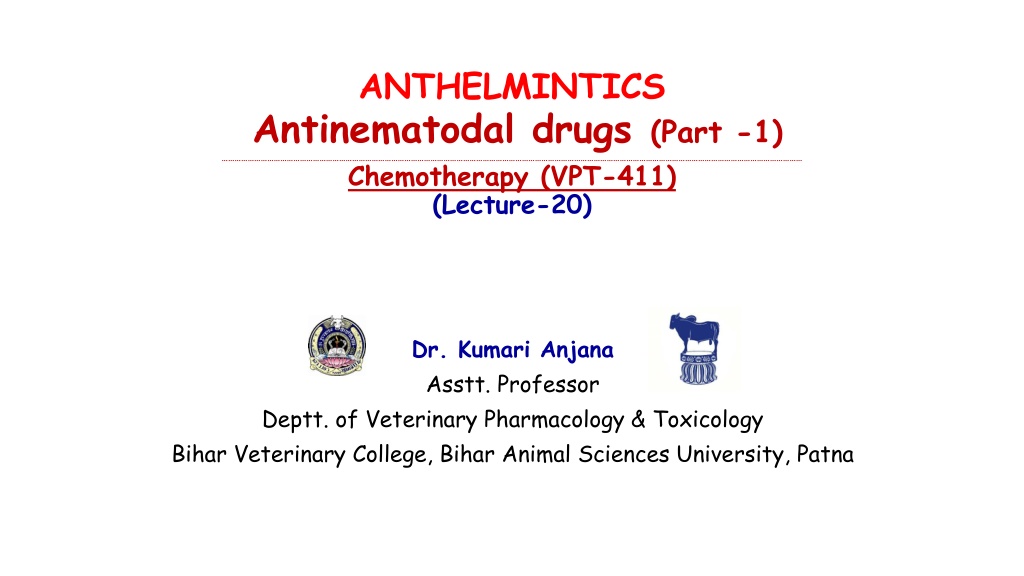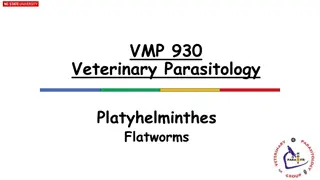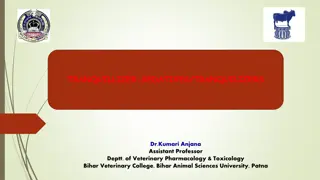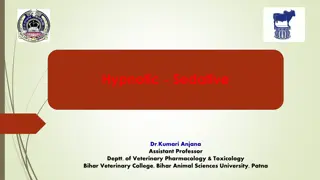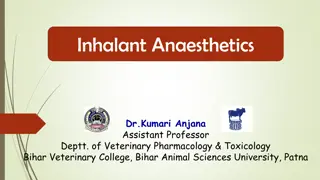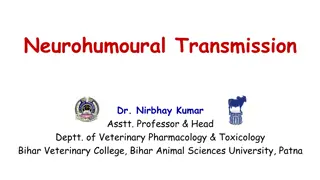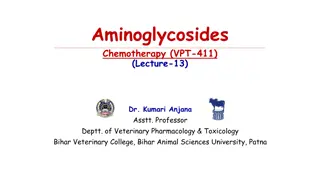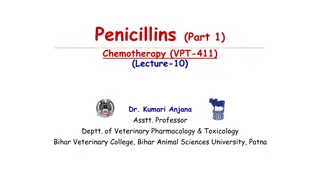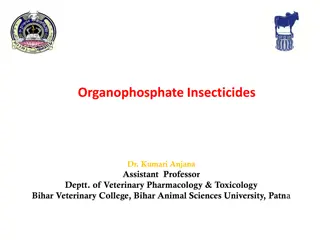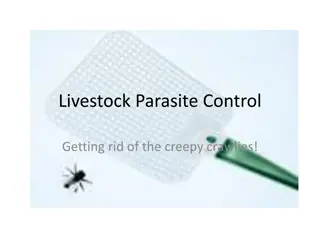Understanding Anthelmintics in Veterinary Pharmacology
This lecture by Dr. Kumari Anjana covers anthelmintic drugs used in veterinary medicine, focusing on the classification of simple heterocyclic compounds, benzimidazoles, and their prodrugs. It discusses the spectrum, mechanism of action, administration, contraindications, and uses of piperazine and phenothiazine in treating various worm infections in domestic animals.
Download Presentation

Please find below an Image/Link to download the presentation.
The content on the website is provided AS IS for your information and personal use only. It may not be sold, licensed, or shared on other websites without obtaining consent from the author. Download presentation by click this link. If you encounter any issues during the download, it is possible that the publisher has removed the file from their server.
E N D
Presentation Transcript
ANTHELMINTICS Antinematodal drugs (Part -1) Chemotherapy (VPT-411) (Lecture-20) Dr. Kumari Anjana Asstt. Professor Deptt. of Veterinary Pharmacology & Toxicology Bihar Veterinary College, Bihar Animal Sciences University, Patna
Content of the chapter Antinematodal drugs Classification Simple heterocyclic compounds Benzimidazoles/Benzimidazole prodrugs
Classification Simple heterocyclic compounds Benzimidazoles/Benzimidazole prodrugs Imidazothiazoles Tetrahydrophyrimidines Organophosphorous compounds Macrocyclic lactones Drugs used in the treatment of heartworm in dogs Miscellaneous antinematodal compounds
Simple Heterocyclic Compounds Piperazine and its Derivatives: Spectrum They are good for ascarid and nodular worm infections of all the species of domestic animals (100% efficacy). Moderate for pinworm (Oxyuris sp.) infections, variable effect on other worms like hookworms and stronglyes. No effect on whipworms (Trichuris sp), tapeworms and flukes. Chemistry: o Strong base, absorb atmospheric water, stored- container should be tightly closed and protected from light. o It forms hexahydrate of piperazine with moisture. o Available in forms of adepate, citrate, phosphate, sulphate, tartarate and hydrochloride.
MOA: Producing a competitive or non-depolarizing type of neuromuscular blockade like curare. Blockage of succinic acid production by the worm. Reversible inhibition of neuromuscular transmission in the worm by acting like GABA. Results flaccid paralysis loss motility and ability to maintain position in GIT-passively swept along with intestinal peristalsis. Administration: o Orally-usually in feed and water over a 2-day period. o Doses- large animal -110 mg/kg small animals 45-65 mg/kg
Contraindications: In heavy ascarid infections, treatment with piperazine or OP compounds results in intestinal blockade and rupture due to expulsion of large masses of worm simultaneously. Benzimidazoles are preferred in such cases- because the death of worms is slow and expulsion is delayed. Piperazine and oxantel are mutually antagonistic.
Phenothiazine: It was synthesized in 1885 and its anthelmintic activity was detected in 1938. One of the early drugs with a wide range of activity against gastrointestinal nematodes. It was extensively used in cattle, sheep, goats, horses and chickens. Development of truly broad-spectrum anthelmintics in 1960 has reduced the use of phenothiazine. It is now primary used in continuous low level feeding programme for ruminants and for formulation of mixtures with other drugs for broader spectrum. It is still used in horses. Its toxicity has limited its use in swine and totally prevented its use in dog, cat and human.
Spectrum The drug possesses good anthelmintic activity against Stomach worms of ruminants (H. contortus, Ostertagia spp., Trichostrongylus axei), Nodular worms (Oesophagostomum spp.) of ruminants and swine, hookworms (Bunostomum) and Small intestinal nematodes. Despite the greater sensitivity of horses than ruminants to phenothiazine poisoning, the drug is still used in equine because of its excellent efficacy against Strongyles. The drug is ineffective against equine ascarids and bots. The drug is effective against Caecal worm of chickens and turkeys gallinarum. The drug is not effective against parasitic larval stages or immature adult worms of any of the ruminant parasites except immature forms of Haemonchus. It has no action against flukes and tapeworms.
Mode of action: The exact mechanism by which phenothiazine destroys the worm is not known, but be due to: o Inhibition cholinesterase etc.) in the tissue, cells of the parasites. of certain vital enzymes (succinoxidase, glyoxalase, o The drug affect the parasites reproduction and low level of feeding of the drug to animals inhibit the egg production of the parasite remaining in the Gl tract of the host. o Ultimately reduce pasture contamination by the helminth eggs, forms the basis of control measure in cattle and sheep management.
Pharmacokinetics Phenothiazine oral administration phenothiazine sulfoxide enzymes of the intestinal epithelium absorbed liver to tow colorless substance. Leucophenothiazone leucothionol Excreted in urine oxidized in the atmosphere to brown-red dyes Phenothiazone and thionol, which discolors the urine and milk of the animals for several days
Administration: Phenothiazine is insoluble in water so bentonite (colloidal aluminium silicate) is used to keep the drug in suspension and it should be shaken prior to dosing animals. In ruminants, administered orally as a single drench once in a month. Powdered phenothiazine is added to the feed generally for prophylaxis. Fowls are treated with single dose of the drug in feed for a 1-day treatment or once in a month for control of caecal worm infections. Dosage: Single dose treatment. Sheep and Goats: > 27 kg: 25-30 gm; 1 1-23 kg: 12.5 gm; Cattle: 10 gm/45 kg (maximum 70 gm); Calves 10 g
Toxicity: Cattle and swine are more susceptible.Horses are most susceptible. Dullness, Photosensitization is a side effect that may accompany phenothiazine administration in ruminants (especially in calves) and fowls when animals direct sunlight. Accumulation (photodynamic agent) causes photosensitization keratitis. Manifested by -- ulceration of cornea and blindness, reddening and thickening of ear and muzzle and development of scab. of unmetabolized phenothiazine sulfoxide
Contraindications: The drug may cause poisoning in cachectic, weak, anaemic, constipated and emaciated animals and therefore is strictly contraindicated in these animals. Concurrent use of phenothiazine and organophosphates is contraindicated as phenothiazine organophosphate toxicity. potentates The drug is contraindicated in pregnancy (during the last month of gestation).
Pink coloration of milk due to the presence of drug metabolites (harmless) does not allow its commercial use for human consumption for 96 hours and therefore cannot be used in lactating animals. The red coloring of urine causes permanent discoloration of hair and wool of animals resulting in economic losses, especially to the sheep farmers. There is evidence of drug resistance against some strains of Haemonchus to phenothiazine when used for longer periods.
Benzimidazoles These have broad spectrum of anthelmintic activity, high degree of efficacy, good margin of safety and have versatility of administration. The first benzimidazole introduced in 1960, was thiabendazole (TBZ). The structure of TBZ was modified with an aim to develop related drugs with more desirable anthelmintic properties. The imidazoles possess antibacterial, anthelmintic, antiprotozoal and antifungal actions. Chemistry: All bezimidazoles have same central nucleus i.e. 1,2- diaminobenzene.
Mode of action: All the benzimidazoles act on parasites by interfering with their energy metabolism: All benzimidazoles except mebendazole and flubendazole, are inhibitors of fumerate reductase enzyme system and thereby inhibit the generation of mitochondrial ATP. In the absence of usable energy, the parasite dies. Mebendazole and flubendazole primarily act by inhibiting glucose transport. They bind to free beta-tubulin, inhibiting its polymerization and thus interfering with microtubule-dependent glucose uptake.
In absence of glucose there is depletion of the worm's glycogen reserve, which renders its unable to produce ATP necessary for survival. But these two do not inhibit fumerate reductase system. The primary site of action of cambendazole and fenbendazole is fumerate reductase inhibition. In addition, like mebendazole and flubendazole they also inhibit glucose transport. This explains their effecteness against certain parasites that lack fumerate reductase system. Thiabendazole also inhibits egg production by helminths by inhibiting protein synthesis.
Thiabendazole (R & LF) : It is rapidly absorbed and rapidly eliminated within 48 hours. Its zero day withdrawl period ensures its popularity with farmers. It may also be used in lactating cows producing milk for human consumption. Dosages: Oral: Cattle: 100 mg/kg; sheep: 50-75 mg/kg; Horse: 50 mg/kg Poultry: 1000 mg/kg.
Albendazole (R,T, LF): The drug is metabolized to the sulphones and sulfoxide which may provide the liver fluke and tapeworm activity. Withdrawl period for slaughter of cattle and sheep is 10-14 days and lactating cows should not be treated with albendazole. High doses may be embryotoxic and teratogenic.
Cambendazole (R, T): Mainly used to treat pig and avian roundworms embryotoxic and teratogenic. Fenbendazole (R, T, LF): No embryotoxicity. For Ascarids in horses and swine and Moniezia in ruminants @ 10mg/kg. Effective against GI nematodes and lungworms. Embrytoxic and teratogenic.
Flubendazole (R): Mainly used to treat pig roundworms, tape worms (including larvae). It has some antifilarial activity. No embryotoxicity. Oxfendazole (R, T, FL): Oxfendazole is the sulfoxide metabolite of fenbendazole and responsible for the activity of both these anthelmintics.
Oxibendazole (R): Usually employed as horse anthelmintic. No teratogenic or mutagenic effects. Mainly used in sheep. It is an antitrematodal drug. Luxabendazole (R, FL): No teratogenic or mutagenic effects. Mainly used in sheep. Dosage: Oral: 7.5 mg/kg (10 mg/kg for flukes). Triclabendazole (FL): It is an antitrematodal drug.
Administration: Benzimidazoles are administered only orally as drench, or as powder or granules in feed. Parbendazole, cambendazole and albendazole produce a teratogenic effect when given to pregnant ewes in early pregnancy (first 45 days) and therefore these types of drugs are contraindicated during early pregnancy in sheep and cattle. Mebendazole, fenbendazole, oxfendazole, flubendazole, luxabendazole and thiophanate are free from teratogenic effects.
Benzimidazole Pro-Drugs These compounds are metabolised in vivo to produce benzimidazoles and need to be administered at doses high enough to produce sufficient active metabolites. Their mode of action, pharmacokinetics and spectrum of activity are similar to those of benzimidazoles. These drugs are: Febantel, Netobimin, Thiophanate
Febantel (R): It is a precursor of fenbendazole. Effective against GI nematodes. Netobimin (R,T,FL): It is a pro drug of albendazole. Effective against GI nematodes, their larvae, tapeworms and flukes. Thiophanate (R): It products the metabolite lobendazole. Active against most nematodes of farm animals. Only orally as drench, or as powder or granules in feed.
Summary Mebendazole, fenbendazole, oxfendazole, flubendazole, luxabendazole and thiophanate are free from teratogenic effects. Oxibendazole--Usually employed as horse anthelmintic. Triclabendazole (FL): It is an antitrematodal drug. Pink coloration of milk due to the presence of drug metabolites.
